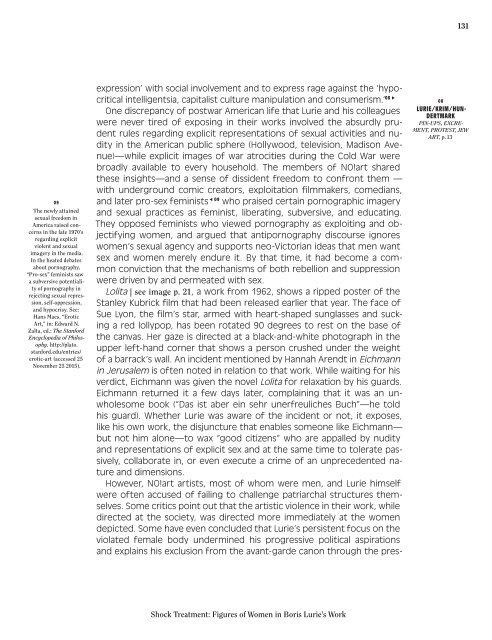The Art of
Katalog_Boris-Lurie_English
Katalog_Boris-Lurie_English
You also want an ePaper? Increase the reach of your titles
YUMPU automatically turns print PDFs into web optimized ePapers that Google loves.
131<br />
09<br />
<strong>The</strong> newly attained<br />
sexual freedom in<br />
America raised concerns<br />
in the late 1970’s<br />
regarding explicit<br />
violent and sexual<br />
imagery in the media.<br />
In the heated debates<br />
about pornography,<br />
“Pro-sex” feminists saw<br />
a subversive potentiality<br />
<strong>of</strong> pornography in<br />
rejecting sexual repression,<br />
self-oppression,<br />
and hypocrisy. See:<br />
Hans Maes, “Erotic<br />
<strong>Art</strong>,” in: Edward N.<br />
Zalta, ed.: <strong>The</strong> Stanford<br />
Encyclopedia <strong>of</strong> Philosophy.<br />
http://plato.<br />
stanford.edu/entries/<br />
erotic-art (accessed 25<br />
November 25 2015).<br />
expression’ with social involvement and to express rage against the ‘hypocritical<br />
intelligentsia, capitalist culture manipulation and consumerism.’ 08<br />
One discrepancy <strong>of</strong> postwar American life that Lurie and his colleagues<br />
were never tired <strong>of</strong> exposing in their works involved the absurdly prudent<br />
rules regarding explicit representations <strong>of</strong> sexual activities and nudity<br />
in the American public sphere (Hollywood, television, Madison Avenue)—while<br />
explicit images <strong>of</strong> war atrocities during the Cold War were<br />
broadly available to every household. <strong>The</strong> members <strong>of</strong> NO!art shared<br />
these insights—and a sense <strong>of</strong> dissident freedom to confront them —<br />
with underground comic creators, exploitation filmmakers, comedians,<br />
and later pro-sex feminists 09 who praised certain pornographic imagery<br />
and sexual practices as feminist, liberating, subversive, and educating.<br />
<strong>The</strong>y opposed feminists who viewed pornography as exploiting and objectifying<br />
women, and argued that antipornography discourse ignores<br />
women’s sexual agency and supports neo-Victorian ideas that men want<br />
sex and women merely endure it. By that time, it had become a common<br />
conviction that the mechanisms <strong>of</strong> both rebellion and suppression<br />
were driven by and permeated with sex.<br />
Lolita | see image p. 21, a work from 1962, shows a ripped poster <strong>of</strong> the<br />
Stanley Kubrick film that had been released earlier that year. <strong>The</strong> face <strong>of</strong><br />
Sue Lyon, the film’s star, armed with heart-shaped sunglasses and sucking<br />
a red lollypop, has been rotated 90 degrees to rest on the base <strong>of</strong><br />
the canvas. Her gaze is directed at a black-and-white photograph in the<br />
upper left-hand corner that shows a person crushed under the weight<br />
<strong>of</strong> a barrack’s wall. An incident mentioned by Hannah Arendt in Eichmann<br />
in Jerusalem is <strong>of</strong>ten noted in relation to that work. While waiting for his<br />
verdict, Eichmann was given the novel Lolita for relaxation by his guards.<br />
Eichmann returned it a few days later, complaining that it was an unwholesome<br />
book (“Das ist aber ein sehr unerfreuliches Buch”—he told<br />
his guard). Whether Lurie was aware <strong>of</strong> the incident or not, it exposes,<br />
like his own work, the disjuncture that enables someone like Eichmann—<br />
but not him alone—to wax “good citizens” who are appalled by nudity<br />
and representations <strong>of</strong> explicit sex and at the same time to tolerate passively,<br />
collaborate in, or even execute a crime <strong>of</strong> an unprecedented nature<br />
and dimensions.<br />
However, NO!art artists, most <strong>of</strong> whom were men, and Lurie himself<br />
were <strong>of</strong>ten accused <strong>of</strong> failing to challenge patriarchal structures themselves.<br />
Some critics point out that the artistic violence in their work, while<br />
directed at the society, was directed more immediately at the women<br />
depicted. Some have even concluded that Lurie’s persistent focus on the<br />
violated female body undermined his progressive political aspirations<br />
and explains his exclusion from the avant-garde canon through the pres-<br />
08<br />
LURIE/KRIM/HUN-<br />
DERTMARK<br />
PIN-UPS, EXCRE-<br />
MENT, PROTEST, JEW<br />
ART, p. 13<br />
Shock Treatment: Figures <strong>of</strong> Women in Boris Lurie’s Work



